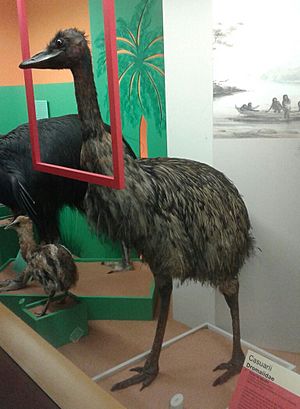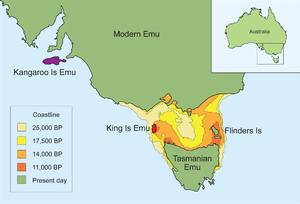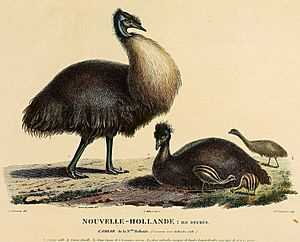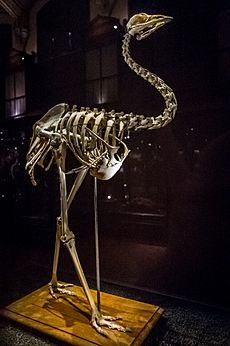Kangaroo Island emu facts for kids
Quick facts for kids Kangaroo Island emu |
|
|---|---|
 |
|
| Only known skin, Natural History Museum of Geneva | |
| Conservation status | |
| Scientific classification |
|
| Kingdom: | Animalia |
| Phylum: | Chordata |
| Class: | Aves |
| Order: | Casuariiformes |
| Family: | Casuariidae |
| Genus: | Dromaius |
| Species: |
D. novaehollandae
|
| Subspecies: |
†D. n. baudinianus
|
| Trinomial name | |
| Dromaius novaehollandae baudinianus Parker, S.A., 1984
|
|
 |
|
| Geographic distribution of emu taxa and historic shoreline reconstructions around Tasmania, D. n. baudinianus in purple | |
| Synonyms | |
|
Casuarius diemenianus Jennings,1827 |
|
The Kangaroo Island emu or dwarf emu (Dromaius novaehollandiae baudinianus) was a type of emu that is now extinct. It lived only on Kangaroo Island in South Australia. This island was once called Ile Decrés by French explorers. This emu was smaller than the emus found on the mainland of Australia. Sadly, this special emu became extinct around 1827.
Contents
How Scientists Studied the Kangaroo Island Emu
The Kangaroo Island emu was first written about in 1802 by Matthew Flinders. He noted that it was quite common near Nepean Bay. The first bones of this emu were found in 1903. They were discovered in sandhills on the west side of Cape Gantheaume.
For a long time, scientists were unsure about the Kangaroo Island emu. They often confused it with the King Island emu. Both types of dwarf emus were taken to France by the same expedition. The old travel journals did not clearly state where each emu was found. This made people think they were the same kind of emu.
Naming the Kangaroo Island Emu
Later, scientists found more old bones, called sub-fossil material. These finds, along with new studies, showed that the King Island and Kangaroo Island emus were different. They came from separate islands and looked different.
In 1984, a scientist named Shane A. Parker finally gave the Kangaroo Island emu its proper name: Dromaius baudinianus. He named it after the leader of the French expedition, Nicolas Baudin. Parker used a sub-fossil bone from Kangaroo Island as the main example for the species. This special bone, a left leg bone, is called the holotype.
What We Know About This Emu
We know about the Kangaroo Island emu from old stories by people who saw them. We also know about them from their bones. There are collections of these bones at the South Australian Museum.
There is only one known skin of this emu left. It is displayed at the Natural History Museum of Geneva in Switzerland. The skeleton in the Natural History Museum of Paris belongs to the same emu as the skin.
Scientists believe this emu lived in the forests inside Kangaroo Island. It became extinct because people hunted it and cleared its forest home by burning.
How Humans Interacted with the Emus

During the French expedition, several emus were sent to France. Some were alive, and some were skins. Today, some of these specimens are in museums in Europe.
One ship, Le Naturaliste, brought one live mainland emu and one skin to France in 1803. Another ship, Le Géographe, collected emus from both King Island and Kangaroo Island. At least two live King Island emus were taken to France in 1804. This ship also brought skins of five young emus from different islands.
The Mystery of the Drawings
In 1807, an account of the expedition was published. It included a drawing by Charles-Alexandre Lesueur, the artist on the voyage. The drawing showed "casoars" (emus) from "Ile Decrès," which is Kangaroo Island. However, there is some confusion about what the drawing actually shows.
The drawing shows two adult emus, labeled as a male and female, with young ones around them. This family scene is probably not real. Mainland emus, for example, do not stay together as a family once the male starts sitting on the eggs. Also, Lesueur's early sketches suggest he drew these emus after seeing them in a garden in France, not in the wild.
A museum expert, Stephanie Pfennigwerth, has suggested something different. She thinks the larger "male" emu in the drawing might be a Kangaroo Island emu that lived in captivity. The smaller, darker "female" might be a King Island emu. This means the drawing shows a made-up scene. The two emus might have been thought to be a male and female of the same type just because they were different sizes.
One of the emus in the drawing has a bent claw. This might mean it lived in captivity. It could also be the same emu as the Kangaroo Island emu skeleton in Paris, which has a deformed toe. The young emu on the right side of the drawing might be based on a King Island emu skin in Paris. This young emu might have been the one that died on the ship during bad weather.
See also
 In Spanish: Emú de la isla Canguro para niños
In Spanish: Emú de la isla Canguro para niños



